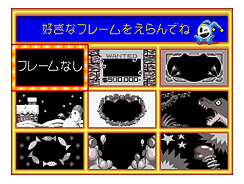
Print Club Vol. 1 © 1995 Atlus.
Print Club is a small photo booth found at video game arcades in Japan. The Print Club machines produce these small photo stickers (about 2.5 x 2 cm, slightly smaller than a postage stamp) which feature a large variety of superimposed frames which compliment the subject's faces. You just pay 300 yen, stand in front of a video monitor which shows your face, choose the desired frame, pose for the photo, then wait for a sheet of 16 photo stickers which the machine spits out in about a minute. The image quality is not so high (this is probably part of the charm), but the sticker is so small that it really doesn't matter. People affix the stickers on personal articles like notebooks, cell phones, etc. But mainly, school girls collect them to show friends.
Runs Sega "System C-2" hardware.
Players: 1
Control: 2-way joystick
Buttons: 2
* Print Club History : The Print Club concept was invented in 1994-1995 by 30-year-old Sasaki Miho, a female employee of one of the two companies which developed the Print Club machine. Without a doubt, she has earned a place in Japan's pop culture history. She thought about how neat it would be to have a small photo sticker with your picture on it. And she thought about those cute stickers with cute characters on them which she stuck on her notebook, etc., during her college days. The first Print Club machine was introduced at a video arcade trade fair in Feb. 1995 before making its debut at video arcades later in June the same year. At first, nothing really happened. Then a popular teeny-bopper male singing group called SMAP started offering Print Club photo stickers of themselves to viewers of their TV program. Other TV stations started doing the same thing, offering viewers Print Club stickers by a drawing. This explains why Print Club first became popular among school girls. They were followers of their idol group, SMAP which includes heartthrob Kimura Takuya. Print Club consequently first caught on among Japanese female high schoolers who usually posed in pairs. The fad soon spread to younger school girls and by 1996, Print Club became widely popular among kids and adults alike. From the end of 1995, Print Club machine sales took off at 1.225 million yen per unit. By the end of 1996, 10,000 units were sold in Japan. By spring 1998, 25,000 Print Club machines (and many other imitation machines) were on the market. School girls may spend up to 2,000 yen per day for these stickers. There is even a store in Harajuku, Tokyo which sells old Print Club machines.
* Why It's So Popular : Print Club is called a new communication tool. With so many frames having different messages such as 'Thank you', 'Happy New Year', and 'I love you', people are sticking them on letters, postcards, notebooks, business cards, etc. Even Ginza bar hostesses stick them on their cards so that customers remember them. It is also a social tool for these school girls since they are motivated to assemble these photo stickers with as many of their friends as they can. They want to show how many friends they have by posing with them on these stickers. And they show these stickers to their friends and share gossip. It's like getting your high school yearbook signed by as many people as possible (this custom, by the way, does not exist in Japan). They even use the stickers to set up introductions to the opposite sex. 'Print Club miai' occurs when a friend gives her photo stickers to another friend who shows them to a prospective boyfriend. They decide to meet or not by looking at their photo stickers. There was a time when girls stuck their Print Club stickers on a bulletin board next to the machine and wrote their beeper/pager numbers as well, inviting calls from males for friendship or even 'financially-assisted relationships' (enjo kosai). These bulletin boards were later banned by the police. Print Club has since had a clean, positive image.
* Spin-offs : With the huge success of Print Club, many other companies have gotten into the act. Print Club (a trademark) is no longer alone in the photo sticker market. You now have a wide choice of photo sticker machines from different manufacturers. The number of frames you can use is almost unlimited. But not only photo stickers, Print Club has inspired a slew of other imaginative machines for imaginative novelties. Some are fairly successful while others are not making much money. But none are as popular as photo sticker machines. For example, Sega Enterprises, one of the makers of the original Print Club machine, has introduced "Stamp Club" (a rubber stamp of your face in the frame of your choice), "Name Club" (for business cards [name and phone No. only] featuring a cartoon character), "Movie Club" (6 poses for an animated image), "Calendar Club" (1 sheet for a desktop calendar with your face), "Aura Photo Club" (captures the aura around your head and shoulders), and even "Aroma Club" which dispenses a vial of fragrance which the machine selects after the user answers a few health questions. The aroma is then supposed to help ease the user's health ailment. Then there is Voice de Holder (Voice Key Chain) which is a key chain with a voice message that you record in the booth. You can then give it to the person you want to give the message to. Although Sega Enterprises is leading the pack for these machines, rivals such as SNK, Konami, and Jaleco are also putting out new machines at a fast pace.
Game's ROM.
PhotoGuide Japan; http://www.photojpn.org